2.7.2: Geometrical Shapes
- Page ID
- 72531
- know what a polygon is
- know what perimeter is and how to find it
- know what the circumference, diameter, and radius of a circle is and how to find each one
- know the meaning of the symbol ππ and its approximating value
- know what a formula is and four versions of the circumference formula of a circle
- know the meaning and notation for area
- know the area formulas for some common geometric figures
- be able to find the areas of some common geometric figures
- know the meaning and notation for volume
- know the volume formulas for some common geometric objects
- be able to find the volume of some common geometric objects
Polygons
We can make use of conversion skills with denominate numbers to make measurements of geometric figures such as rectangles, triangles, and circles. To make these measurements we need to be familiar with several definitions.
A polygon is a closed plane (flat) figure whose sides are line segments (portions of straight lines).
Polygons




Not polygons




Perimeter
The perimeter of a polygon is the distance around the polygon.
To find the perimeter of a polygon, we simply add up the lengths of all the sides.
Find the perimeter of each polygon.

- Solution
-
\(\begin{array} {rcl} {\text{Perimeter}} & = & {\text{2 cm + 5 cm + 2 cm + 5 cm}} \\ {} & = & {\text{14 cm}} \end{array}\)

- Solution
-
\(\begin{array} {rcr} {\text{Perimeter}} & = & {\text{3.1 mm}} \\ {} & & {\text{4.2 mm}} \\ {} & & {\text{4.3 mm}} \\ {} & & {\text{1.52 mm}} \\ {} & & {\text{5.4 mm}} \\ {} & & {\underline{\text{+ 9.2 mm}}} \\ {} & & {\text{27.72 mm}} \end{array}\)

- Solution
-
Our first observation is that three of the dimensions are missing. However, we can determine the missing measurements using the following process. Let A, B, and C represent the missing measurements. Visualize
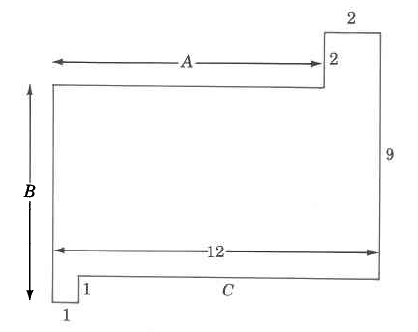
\(\text{A = 12m - 2m = 10m}\)
\(\text{B = 9m + 1m - 2m = 8m}\)
\(\text{C = 12m - 1m = 11m}\)\(\begin{array} {rcr} {\text{Perimeter}} & = & {\text{8 m}} \\ {} & & {\text{10 m}} \\ {} & & {\text{2 m}} \\ {} & & {\text{2 m}} \\ {} & & {\text{9 m}} \\ {} & & {\text{11 m}} \\ {} & & {\text{1 m}} \\ {} & & {\underline{\text{+ 1 m}}} \\ {} & & {\text{44 m}} \end{array}\)
Practice Set A
Find the perimeter of each polygon.
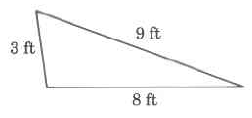
- Answer
-
20 ft
Practice Set A
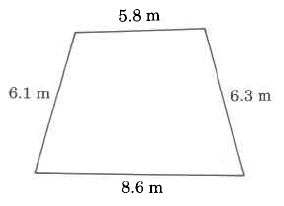
- Answer
-
26.8 m
Practice Set A
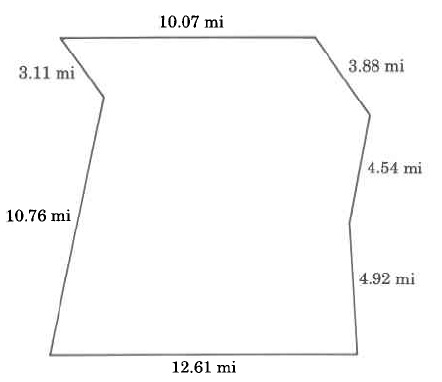
- Answer
-
49.89 mi
Circumference/Diameter/Radius
Diameter (d)
A diameter of a circle is any line segment that passes through the center of the circle and has its endpoints on the circle.
Radius (r)
A radius of a circle is any line segment having as its endpoints the center of the circle and a point on the circle.
The radius is one half the diameter.
Circumference (C)
The circumference of a circle is the distance around the circle. It is given by \(C = \pi d= 2 \pi r\)
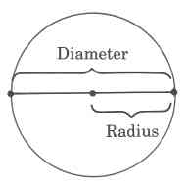
Find the circumference of the circle.
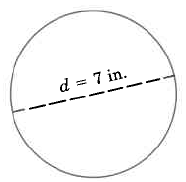
- Solution
-
Use the formula \(C = \pi d\).
\(C = \pi \cdot 7\ in.\)
By commutativity of multiplication,
\(C = 7\ in. \cdot \pi\)
\(C = 7 \pi in.\), exactly
This result is exact since \(\pi\) has not been approximated.
Find the perimeter of the figure.
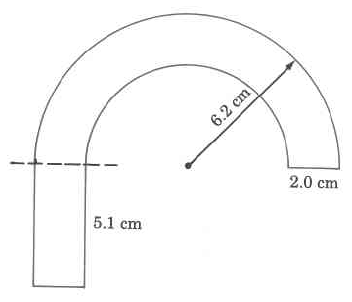
- Solution
-
We notice that we have two semicircles (half circles).
The larger radius is 6.2 cm.
The smaller radius is \(\text{6.2 cm - 2.0 cm = 4.2 cm.}\)
The width of the bottom part of the rectangle is 2.0 cm.
\(\begin{array} {rcll} {\text{Perimeter}} & = & {\text{2.0 cm}} & {} \\ {} & & {\text{5.1 cm}} & {} \\ {} & & {\text{2.0 cm}} & {} \\ {} & & {\text{5.1 cm}} & {} \\ {} & & {(0.5) \cdot (2) \cdot (3.14) \cdot \text{(6.2 com)}} & {\text{Circumference of outer semicircle.}} \\ {} & \ \ + & {\underline{(0.5) \cdot (2) \cdot (3.14) \cdot \text{(4.2 com)}}} & {\text{Circumference of inner semicircle.}} \\ {} & & {} & {\text{6.2 cm - 2.0 cm = 4.2 cm}} \\ {} & & {} & {\text{The 0.5 appears because we want the}} \\ {} & & {} & {\text{perimeter of only half a circle.}} \end{array}\)
\(\begin{array} {rcr} {\text{Perimeter}} & \approx & {\text{2.0 cm}} \\ {} & & {\text{5.1 cm}} \\ {} & & {\text{2.0 cm}} \\ {} & & {\text{5.1 cm}} \\ {} & & {\text{19.468 cm}} \\ {} & & {\underline{\text{+13.188 cm}}} \\ {} & & {\text{48.856 cm}} \end{array}\)
Practice Set B
Find the outside perimeter of
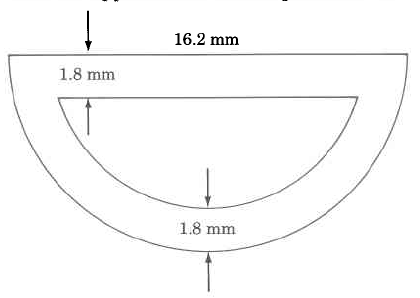
- Answer
-
41.634 mm
The Meaning and Notation for Area
The product \(\text{(length unit)} \cdot \text{(length unit)} = \text{(length unit)}^2\), or, square length unit (sq length unit), can be interpreted physically as the area of a surface.
Area
The area of a surface is the amount of square length units contained in the surface.
For example, 3 sq in. means that 3 squares, 1 inch on each side, can be placed precisely on some surface. (The squares may have to be cut and rearranged so they match the shape of the surface.)
We will examine the area of the following geometric figures.





Finding Areas of Some Common Geometric Figures
Find the area of the triangle.

- Solution
-
\(\begin{array} {rcl} {A_T} & = & {\dfrac{1}{2} \cdot b \cdot h} \\ {} & = & {\dfrac{1}{2} \cdot 20 \cdot 5 \text{ sq ft}} \\ {} & = & {10 \cdot 6 \text{ sq ft}} \\ {} & = & {60 \text{ sq ft}} \\ {} & = & {60 \text{ ft}^2} \end{array}\)
The area of this triangle is 60 sq ft, which is often written as 60 \(\text{ft}^2\).
Find the area of the rectangle.

- Solution
-
Let's first convert 4 ft 2 in. to inches. Since we wish to convert to inches, we'll use the unit fraction \(\dfrac{\text{12 in.}}{\text{1 ft}}\) since it has inches in the numerator. Then,
\(\begin{array} {rcl} {\text{4 ft}} & = & {\dfrac{\text{4 ft}}{1} \cdot \dfrac{\text{12 in.}}{\text{1 ft}}} \\ {} & = & {\dfrac{4 \cancel{\text{ ft}}}{1} \cdot \dfrac{\text{12 in.}}{1 \cancel{\text{ ft}}}} \\ {} & = & {\text{48 in.}} \end{array}\)
Thus, \(\text{4 ft 2 in. = 48 in. + 2 in. = 50 in.}\)
\(\begin{array} {rcl} {A_R} & = & {l \cdot w} \\ {} & = & {\text{50 in.} \cdot \text{8 in.}} \\ {} & = & {400 \text{ sq in.}} \end{array}\)
The area of this rectangle is 400 sq in.
Find the area of the parallelogram.

- Solution
-
\(\begin{array} {rcl} {A_P} & = & {b \cdot h} \\ {} & = & {\text{10.3 cm} \cdot \text{6.2 cm}} \\ {} & = & {63.86 \text{ sq cm}} \end{array}\)
The area of this parallelogram is 63.86 sq cm.
Find the area of the trapezoid.

- Solution
-
\(\begin{array} {rcl} {A_{Trap}} & = & {\dfrac{1}{2} \cdot (b_1 + b_2) \cdot h} \\ {} & = & {\dfrac{1}{2} \cdot (\text{14.5 mm + 20.4 mm}) \cdot (4.1 \text{ mm})} \\ {} & = & {\dfrac{1}{2} \cdot (\text{34.9 mm}) \cdot (4.1 \text{ mm})} \\ {} & = & {\dfrac{1}{2} \cdot \text{(143.09 sq mm)}} \\ {} & = & {71.545 \text{ sq mm}} \end{array}\)
The area of this trapezoid is 71.545 sq mm.
Find the approximate area of the circle.

- Solution
-
\(\begin{array} {rcl} {A_c} & = & {\pi \cdot r^2} \\ {} & \approx & {(3.14) \cdot (16.8 \text{ ft})^2} \\ {} & \approx & {(3.14) \cdot (\text{282.24 sq ft})} \\ {} & \approx & {888.23 \text{ sq ft}} \end{array}\)
The area of this circle is approximately 886.23 sq ft.
The Meaning and Notation for Volume
The product \(\text{(length unit)}\text{(length unit)}\text{(length unit)} = \text{(length unit)}^3\), or cubic length unit (cu length unit), can be interpreted physically as the volume of a three-dimensional object.
Volume
The volume of an object is the amount of cubic length units contained in the object.
For example, 4 cu mm means that 4 cubes, 1 mm on each side, would precisely fill some three-dimensional object. (The cubes may have to be cut and rearranged so they match the shape of the object.)

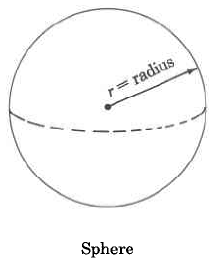
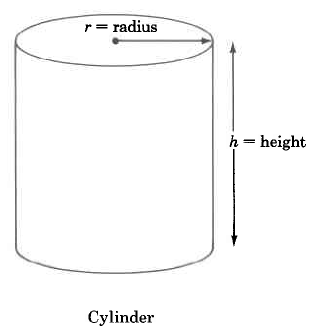

Finding Volumes of Some Common Geometric Objects
Find the volume of the rectangular solid.
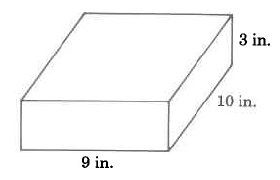
- Solution
-
\(\begin{array} {rcl} {V_R} & = & {l \cdot w \cdot h} \\ {} & = & {\text{9 in.} \cdot \text{10 in.} \cdot \text{3 in.}} \\ {} & = & {\text{270 cu in.}} \\ {} & = & {\text{270 in.}^3} \end{array}\)
The volume of this rectangular solid is 270 cu in.
Find the approximate volume of the sphere.
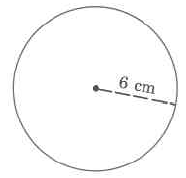
- Solution
-
\(\begin{array} {rcl} {V_S} & = & {\dfrac{4}{3} \cdot \pi \cdot r^3} \\ {} & \approx & {(\dfrac{4}{3}) \cdot (3.14) \cdot \text{(6 cm)}^3} \\ {} & \approx & {(\dfrac{4}{3}) \cdot (3.14) \cdot \text{(216 cu cm)}} \\ {} & \approx & {\text{904.32 cu cm}} \end{array}\)
The approximate volume of this sphere is 904.32 cu cm, which is often written as 904.32 cm\(^3\).
Find the approximate volume of the cylinder.

- Solution
-
\(\begin{array} {rcl} {V_{Cyl}} & = & {\pi \cdot r^2 \cdot h} \\ {} & \approx & {(3.14) \cdot (\text{4.9 ft})^2 \cdot \text{(7.8 ft)}} \\ {} & \approx & {(3.14) \cdot (\text{24.01 sq ft}) \cdot \text{(7.8 ft)}} \\ {} & \approx & {(3.14) \cdot \text{(187.278 cu ft)}} \\ {} & \approx & {\text{588.05292 cu ft}} \end{array}\)
The volume of this cylinder is approximately 588.05292 cu ft. The volume is approximate because we approximated \(\pi\) with 3.14.
Find the approximate volume of the cone. Round to two decimal places.
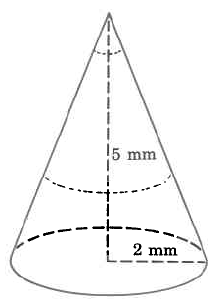
- Solution
-
\(\begin{array} {rcl} {V_{c}} & = & {\dfrac{1}{3} \cdot \pi \cdot r^2 \cdot h} \\ {} & \approx & {(\dfrac{1}{3}) \cdot (3.14) \cdot (\text{2 mm})^2 \cdot \text{(5 mm)}} \\ {} & \approx & {(\dfrac{1}{3}) \cdot (3.14) \cdot (\text{4 sq mm}) \cdot \text{(5 mm)}} \\ {} & \approx & {(\dfrac{1}{3}) \cdot (3.14) \cdot \text{(20 cu mm)}} \\ {} & \approx & {20.9\overline{3} \text{ cu mm}} \\ {} & \approx & {\text{20.93 cu mm}} \end{array}\)
The volume of this cone is approximately 20.93 cu mm. The volume is approximate because we approximated \(\pi\) with 3.14.
Table of Formulas for Common Shapes
| Figure | Formulas | |
| Square |
.png)
|
\[P=4 s \]
\[A=s^{2}\] |
| Rectangle |
.png)
|
\[P=2 l+2 w \]
\[A=l w\] |
| Parallelogram |
.png)
|
\[P=2 a+2 b\]
\[A=b h\] |
| Trapezoid |
.png)
|
\[P=a+b+c+d\]
\[A=\frac{1}{2} h(a+b)\] |
| Triangle |
.png)
|
\[P=a+b+c\]
\[A=\frac{1}{2} b h\] |
| Circle |
.png)
|
\[C=2 \pi \]
\[r=\pi r^{2}\] Volume (V) is measured in cubic units and surface area (SA) is measured in square units. |
| Cube |
.png)
|
\[S A=6 s^{2}\]
\[V=s^{3}\] |
| Rectangular Solid |
.png)
|
\[S A=2 l w+2 l h+2 w h\]
\[V=l w h\] |
| Right Circular Cylinder |
.png)
|
\[S A=2 \pi r^{2}+2 \pi r h\]
\[V=\pi r^{2} h\] |
| Right Circular Cone |
.png)
|
\[S A=\pi r^{2}+\pi r s\]
\[V=\frac{1}{3} \pi r^{2} h\] |
| Sphere |
.png)
|
\[S A=4 \pi r^{2}\]
\[V=\frac{4}{3} \pi r^{3}\] |


